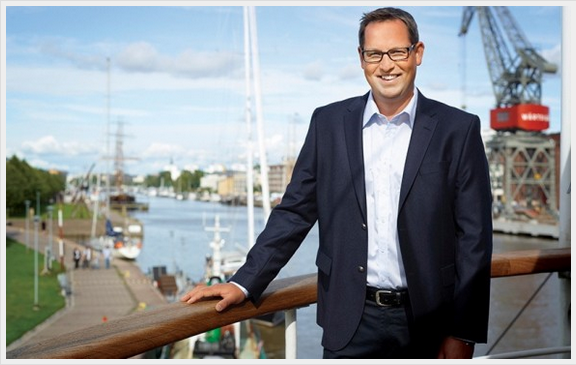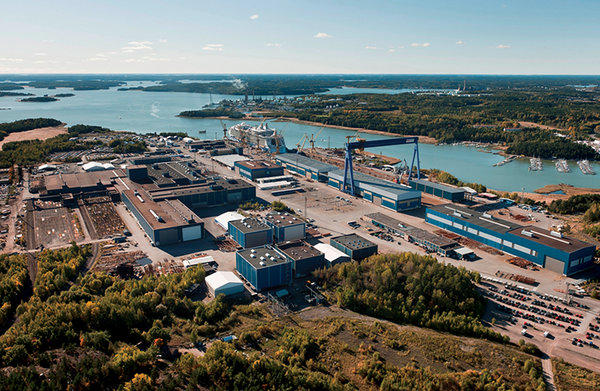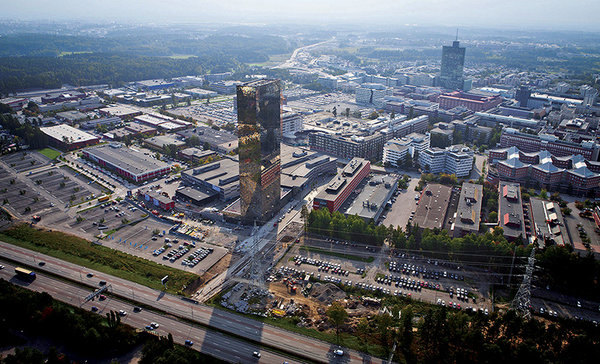
Photo: Aleksi-Randell-Mayor-of-Turku
How public-private planning can benefit cities
19 January 2015
by Richard Forster
Jonathan Andrews talked to the Mayor of Turku about how the Urban Infrastructure Initiative is helping the city realise its sustainable goals
How was Turku chosen to be one of the pilot cities in the World Business Council for Sustainable Development’s (WBCSD) Urban Infrastructure Initiative (UII)?
I believe we were chosen due to our strong record of sustainability and cooperation. It also helped that the interest was specifically on middle-sized cities.
A key finding in the report notes that instead of cities putting up tenders in a very rigorous framework, cities should say ‘these are the problems’ what can you, the private sector, offer us?’ Do you think a broader approach is the way forward?
Yes, definitely, and taking this into account also in tenders is important. However, making better tenders alone is not enough. Cities and businesses need new knowledge and new solutions and these are best created together. Both sides need to take a proactive role in analysing the urban challenges and creating the solutions. A well-structured involvement of universities helps too.
What else can Turku take away from its involvement as a pilot city in this report, in particular in dealings with the private sector?
We have learned new approaches to cooperate with businesses and will continue to develop and implement them. Working with the private sector has a very important role in our newly adopted city strategy.
Will there be further involvement with the WBCSD?
We are grateful for the UII experience and positively open to new opportunities. The UII process on our side has been followed-up by a three-year strategic cooperation partnership with Siemens. We are carrying out studies together on our key development challenges.
What has been the reaction since the report was released? Has Turku since gained attention from companies wanting to develop sustainable development projects and ideas?
Yes indeed and furthermore, our whole sustainable development agenda has received a fresh boost within the city, its stakeholders and cooperation partners. Sustainable growth and business development are at the core of our new strategy that was approved by the City Council in June.
One of our key fields is marine industry and services, and we see a big potential in blue clean tech. In addition to building the world’s largest cruise- ships, we also have the capacity to build the most environmentally friendly ones. The German shipbuilding company, Meyer Werft, has just announced together with the national government that they are buying the Turku ship- dock from its current owner STX and will build several new cruise-ships during the coming years.

Yes, we are regularly both organising and taking part in Finnish, Nordic and Baltic Sea regional gatherings and have shared the learning on several occasions. The UII experience has also become one of our main inputs for the Baltic Sea region forum of smart cities, which is an upcoming regional flagship project.
Although not a megacity, Turku is still experiencing the same trends as large cities. In what way has Turku taken a lead in sustainable development?
We have for a long time promoted active living in a healthy city. Wellbeing and competitiveness are our top priorities. We want to continue on the path of sustainable growth and have set ourselves the goal to be carbon-neutral by 2040. Already we have cut over one-third of our greenhouse gas emissions. The most important action to achieve this has been and continues to be favouring renewable energy.
With which other cities in the region do you work most closely?
We have close cooperation within the six- pack, i.e., the six largest cities in Finland. Important partners in the region include Stockholm and Saint Petersburg. Networks of cities like the Union of the Baltic Cities and ICLEI are also very important channels for partnerships and knowledge.
What do you think sets the Nordic cities apart from others?
Nordic people are very active and aware of societal and environmental topics. They are also well educated and capable of creating new solutions and businesses in new fields. This shows in our cities. It should also be noted that the administrative position of cities is exceptionally strong in the Nordic countries, which gives us powers to steer our development.
The Urban Infrastructure Initiative (UII)
The WBCSD established the UII to advance the urban sustainability agenda by showcasing the critical role that business can play as solutions providers and by providing a platform for collaborative strategic engagement between cities and business. The UII brings together 14 leading member companies–Cemex (Co-Chair), GDF SUEZ (Co-Chair) Siemens (Co-Chair), ACCIONA, AECOM, AGC, EDF, Honda, Nissan, Philips, Schneider Electric, TNT Express, Toyota and United Technologies– with an array of knowledge and skills to help unlock opportunities for urban authorities to create cities that are more sustainable, efficient and liveable.
These companies worked with the following leading cities: Turku (Finland); Tilburg (The Netherlands); Ahmedabad, Rajkot, Surat and Vadodara in Gujarat State (India); Yixing (China); Kobe (Japan); Guadalajara (Mexico); and Philadelphia (USA).
In each city, the UII mobilised a multi-disciplinary team of company experts to work collaboratively with senior city officials. These teams took an integrated, cross-sector approach to analysing the city’s major sustainability challenges and to developing an innovative solutions landscape to address these challenges.

Nordic region opens up procurement to innovation
Kista Science City, Stockholm
The Nordic region has injected fresh approaches to the bureaucratic and often clumsy process that most tendering and procurement stages involve. In 2012 Kista Science City, located near Stockholm and renowned as a mobile industry cluster, launched Sweden’s first pre-commercial procurement (PCP) or ‘lightweight competition’. Together with partners, the City of Stockholm and the Swedish Transport Administration, it aimed to attract and stimulate app developers and small companies to present out-of-the-box solutions to change travel patterns and behaviours within the area.
Ten entries were received, all from small companies, that were then evaluated by a panel of which three winners were chosen. A proviso was included that no subsequent procurement of any solution would be undertaken. Organisers instead wanted to see business models provided that could credibly explain how the services would be funded and find their market. The three winners were chosen due to their strong potential to change travel behaviour and reduce the pressure on the transport system during peak hours.
“We can only hope that we opened up an additional way of attracting a new group of innovators, start-ups and SMEs [small and medium sized enterprises] to engage in processes they would normally regard as too complicated, unprofitable or even boring,” explains Thomas Andersson, CEO, Kista Science City. The winners will have their apps officially launched and commercialised by November. Although there are no concrete plans to create another version, Andersson hopes that the process has inspired the Swedish public sphere to undertake similar pre-commercial procurements.
“Public needs and demands formulated as procurements can be an attractive market to small companies,” he adds. “We not only achieved that but we were able to shorten the normal pre-commercial procurement process considerably, also simplifying it and making it more market-orientated.”
Tekes Smart Procurement Programme, Finland
The Finnish Funding Agency for Technology and Innovation, or Tekes, launched in 2008 its €60-million Smart Procurement Programme to try and stimulate smart public procurement innovations. It was also created to improve market access for innovative products and services and to improve the productivity and effectiveness of public services.
“Too often the criteria used discouraged SMEs to participate in the tender process,” says Sampsa Nissinen, Programme Manager, Smart Procurement Programme, Tekes. “Because of these challenges few local services have been launched that help and encourage SMEs to participate in public procurement.”
The programme aims to turn this around by offering funding for projects related to public procurement of innovation and other value added services including arranging workshops and providing information about innovative procurement cases and methods.
“Our role in Tekes is to promote innovations and improve the competitiveness of Finnish industry,” adds Nissinen. “More and more municipalities are obligated to find new ways to arrange public services. The benefits [that this programme offers] include better collaboration between public services, saving tax payers’ money and stimulating the creation of new markets.”
At the end of last year the programme had helped fund 70 projects, typically half of each project’s total cost, helping more SMEs win a larger proportion of public tenders.
“Promoting local businesses is important for cities and that has also been the trigger for more collaboration between companies in general,” he adds. “The long term vision is for Finland to be known as a model country of smart demand.”








